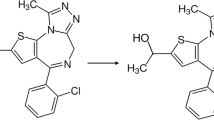Summary
Twelve cases of “preludin” intoxication are described. The physical signs included mydriasis, impaired pupillary response to light and even impaired reaction to accomodation-convergence. Tremor of the tongue and upper limb together with augmented tendon reflexes and facial twitching were noted. Excessive small movements of the hands and touching of the face occurred against a background of generalized overactivity. Mood changes included lability or depression associated with depressive delusions. Paranoid ideas were present in eight subjects, while five had auditory hallucinations. Disorientation, impaired attention and concentration with loss of insight were also encountered. All abnormalities abated within 14 days of drug withdrawal.
Similar content being viewed by others
References
Begg, W. A. G., and A. A. Reid: “Meratran.” A new stimulant drug. Brit. med. J. 1956I, 946–949.
Bethell, M. F.: Toxic psychosis caused by “Preludin”. Brit med. J. 1957I, 30.
Brown, B. B., and H. N. Werner: Pharmacological studies on a new central stimulant, α-(2-piperidyl) benzhydrol hydrochloride (MRD-108). J. Pharmacol. exp. Ther. 110, 180–187 (1954).
Carr, R. B.: Acute psychotic reaction after inhaling methylamphetamine. Brit. med. J. 1954I, 1476.
Cleghorn, R. A.: Drugs that produce deviations in mood, including anxiety, presumably without impairing capacities for orientation or at least secondarily to changes in mood. Amer. J. Psychiat. 108, 568–571 (1952).
Clein, L.: Toxic psychosis caused by preludin. Brit. med. J. 1957I, 282.
Cole, J., and P. Glees: Some effects of methyl-phenidate (ritalin) and amphetamine on normal and leucotomized monkeys. J. ment. Sci. 103, 406–417.
Connell, P.: Amphetamine psychosis. Maudsley Monograph No 5. London: Chapman & Hall 1958a, p. 79; 1958b, p. 28; 1958c, p. 53; 1958d, p. 75; 1958e, p. 54.
Duke-Elder, W. S.: Textbook of ophthalmology, vol. IV, p. 3781. London: Kimpton 1949.
Fullerton, A. G.: Psychiatric uses of meratran. J. ment. Sci. 102, 801–804 (1956).
Glatt, M. M.: Toxic psychosis caused by “Preludin”. Brit. med. J. 1957I, 460 to 461.
Goodman, L. S., and A. Gilman: The pharmacological basis of therapeutics, 2nd ed. New York: Macmillan 1955a, p. 521; 1955b, p. 510.
Guttman, E., and W. Sargant: Observations on Benzedrine. Brit. med. J. 1937I, 1013–1015.
Halliday, A. M., and J. W. T. Redfearn: An analysis of the frequencies of finger tremor in healthy subjects. J. Physiol. (Lond.). 134, 600–611 (1956).
Herman, M., and S. H. Nagler: Psychoses due to amphetamine. J. nerv. ment. Dis. 120, 268–272 (1954).
Howells, D. E.: Nystagmus and other eye signs in acute alcoholism. Brit. med. J. 1952II, 862–864.
Isbell, H.: Addiction to barbiturates and the barbiturate abstinence syndrome. Ann. intern. Med. 33, 108–121 (1950).
Knapp, P. H.: Amphetamine and Addiction. J. nerv. ment. Dis. 115, 406–432 (1952).
Levin, M.: Transitory schizophrenias produced by bromide intoxication. Amer. J. Psychiat. 103, 229–237 (1947).
—: Delirium. A gap in psychiatric treatment. Amer. J. Psychiat. 107, 689–694 (1951).
Locket, S.: Clinical toxicology, p. 351. London: Kimpton 1957.
Lowenstein, O., and I. E. Loewenfeld: Mutual role of sympathetic and parasympathetic in shaping of the pupillary reflex to light. Arch. Neurol. Psychiat. (Chicago) 64, 341–377 (1950).
Macht, M.: Effects of d-amphetamine on hemi-corticate, decorticate, and decerebrate cats. Amer. J. Physiol. 163, 731 (1950).
Maling, H. M., and G. H. Acheson: Righting and other postural activity in lowdecerebrate and in spinal cats after d-amphetamine. J. Neurophysiol. 9, 379–386 (1946).
Marley, E.: Response to drugs, and psychiatry. J. ment. Sci. 105, 19–43 (1959).
Marley, E., and A. A. Bartholomew: Clinical aspects of susceptibility to methylpentynol. J. Neurol. Neurosurg. Psychiat. 21, 129–140 (1958).
Martel, A.: Preludin (phenmetrazine) in the treatment of obesity. Canad. med. Ass. 76, 117–120 (1957).
Mathias, I. G.: Addiction to amphetamine. Lancet 1951I, 1420.
Monroe, R. R., and H. J. Drell: Oral use of stimulants obtained from inhalers. J. Amer. med. Ass. 135, 909–915 (1947).
O'Flanagan, P. M., and R. B. Taylor: A case of recurrent psychosis associated with amphetamine addiction. J. ment. Sci. 96, 1033–1036 (1950).
Patuck, D.: Acute dexamphetamine sulphate poisoning in a child. Brit. med. J. 1956I, 670–671.
Randell, J. B.: Euphoriant effects of “Preludin”. Brit. med. J. 1957II, 508 to 509.
Seager, C. P., and A. R. Foster: Addiction to unrestricted drugs. Brit. med. J. 1958II, 950–952.
Shanson, R.: Amphetamine poisoning. Brit. med. J. 1956I, 576.
Shorvon, H. J.: Use of benzedrine sulphate by psychopaths. Brit. med. J. 1945II, 285–286.
Silverman, M.: Subacute delirious state due to “preludin” addiction. Brit. med. J. 1959I, 696.
Spiegelberg, U.: Klinisch-psychiatrische Erfahrungen mit einem neuen antriebsstreigernden Präparat: 2-phenyl-3-methyl-tetrahydro-1,4-oxazinhydrochlorid. Nervenarzt 25, 276–283 (1954).
Tolentino, I.: Psychotic reactions and psychosis due to β-phenylisopropylamine and sympatho-mimetic drugs (amphetamine group). Psychotropic Drugs, p. 585. Amsterdam: Elsevier Publishing Co. 1957.
Wallis, G. G., J. F. McHarg and O.C.A. Scott: Acute psychosis caused by dextroamphetamine. Brit. med. J. 1949II, 1394.
Wayne, E. J.: The evaluation of drug toxicity. Ed. A. L. Walpole and A. Spinks, p. 1. London: Churchill 1958.
Wolff, H. G., and D. Curran: Nature of delirium and allied states. The dysergastic reaction. Arch. Neurol. Psychiat. (Chicago) 33, 1175–1215 (1935).
Author information
Authors and Affiliations
Rights and permissions
About this article
Cite this article
Bartholomew, A.A., Marley, E. Toxic response to 2-phenyl-3-methyl tetrahydro-1, 4-oxazine hydrochloride “preludin” in humans. Psychopharmacologia 1, 124–139 (1959). https://doi.org/10.1007/BF00409112
Received:
Issue Date:
DOI: https://doi.org/10.1007/BF00409112




